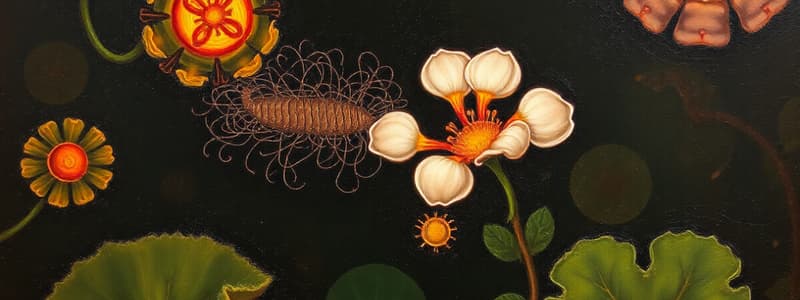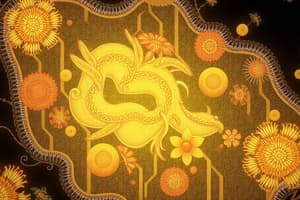Podcast
Questions and Answers
What is the main ingredient of urine?
What is the main ingredient of urine?
- Uric Acid
- Sodium
- Urea (correct)
- Creatinine
Cranial and Spinal Nerves are part of the central nervous system.
Cranial and Spinal Nerves are part of the central nervous system.
False (B)
What is the function of platelets in the human body?
What is the function of platelets in the human body?
Blood clotting
The working unit of the kidney that filters blood is called the ______.
The working unit of the kidney that filters blood is called the ______.
Match the respiratory conditions with their definitions:
Match the respiratory conditions with their definitions:
Which of the following is NOT a characteristic of living things?
Which of the following is NOT a characteristic of living things?
An organism that is unicellular has only one cell.
An organism that is unicellular has only one cell.
What is the largest organ in the human body?
What is the largest organ in the human body?
Particles in a fluid move from high concentration to low concentration in a process called __________.
Particles in a fluid move from high concentration to low concentration in a process called __________.
Match the following organisms to their method of movement:
Match the following organisms to their method of movement:
What is the second largest organ in the human body?
What is the second largest organ in the human body?
Osmosis refers to the movement of solute particles across a membrane.
Osmosis refers to the movement of solute particles across a membrane.
Define structural adaptation and provide an example.
Define structural adaptation and provide an example.
What does the presence of CO2 in exhaled air indicate when exhaling into Bromothymol Blue solution?
What does the presence of CO2 in exhaled air indicate when exhaling into Bromothymol Blue solution?
Arteries have valves, while veins do not.
Arteries have valves, while veins do not.
What are the building blocks of proteins?
What are the building blocks of proteins?
Villi increase surface area to absorb __________ in the small intestine.
Villi increase surface area to absorb __________ in the small intestine.
Match the following components of gastric juice with their functions:
Match the following components of gastric juice with their functions:
What is the primary function of red blood cells?
What is the primary function of red blood cells?
Mechanical digestion involves chemical reactions such as acid and enzymes.
Mechanical digestion involves chemical reactions such as acid and enzymes.
What are xylem and phloem classified as?
What are xylem and phloem classified as?
Flashcards
Function of Platelets
Function of Platelets
Platelets help in blood clotting to prevent bleeding.
Urea
Urea
Urea is a waste product formed from ammonia in the liver.
Nephron
Nephron
The nephron is the kidney's functional unit that filters blood.
Types of Neurons
Types of Neurons
Signup and view all the flashcards
Asthma
Asthma
Signup and view all the flashcards
Characteristics of Living Things
Characteristics of Living Things
Signup and view all the flashcards
Structure and Function
Structure and Function
Signup and view all the flashcards
Structural Adaptation
Structural Adaptation
Signup and view all the flashcards
Cells, Tissues, Organs, Organ Systems
Cells, Tissues, Organs, Organ Systems
Signup and view all the flashcards
Unicellular vs. Multicellular
Unicellular vs. Multicellular
Signup and view all the flashcards
Diffusion
Diffusion
Signup and view all the flashcards
Osmosis
Osmosis
Signup and view all the flashcards
Gas Exchange Structures
Gas Exchange Structures
Signup and view all the flashcards
Xylem vs Phloem
Xylem vs Phloem
Signup and view all the flashcards
Mechanical Digestion
Mechanical Digestion
Signup and view all the flashcards
Chemical Digestion
Chemical Digestion
Signup and view all the flashcards
Gastric Juice Components
Gastric Juice Components
Signup and view all the flashcards
Villi
Villi
Signup and view all the flashcards
Arteries vs Veins
Arteries vs Veins
Signup and view all the flashcards
Gas Exchange Locations
Gas Exchange Locations
Signup and view all the flashcards
Study Notes
Living Things Characteristics
- Living things are made of cells
- Living things need energy
- Living things grow and develop
- Living things reproduce
- Living things respond to their environment
- Living things have adaptations for their environment
Structure and Function
- Structure determines function
- Example: a wing's structure enables flight
Structural Adaptations
- These are changes in a species' structure to aid survival
- Example: a specific example is not provided.
Largest and Second Largest Organs
- Largest organ: Skin
- Second largest organ: Liver
Microscopy and Diagrams
- Diagrams of microscopes and other biological structures should be labeled according to the provided diagrams.
Cells, Tissues, Organs, Organ Systems
- Cells combine to form tissues
- Different tissues combine to create organs
- Organs work together as systems (e.g., the circulatory system)
Unicellular vs. Multicellular
- Unicellular organisms consist of one cell
- Multicellular organisms consist of many cells
Cellular Movement
- Amoeba: Move using pseudopods
- Paramecium: Move using cilia
Diffusion and Osmosis
- Diffusion: Movement of particles from high to low concentration
- Osmosis: Diffusion of water across a membrane
Water Movement Across Membranes
- Water moves from high to low concentration
- Example of a concentration gradient diagram is included.
Xylem and Phloem
- Xylem transports water
- Phloem transports food
- Both are types of transport tissue.
Digestion
- Mechanical digestion: Physical breakdown (e.g., chewing)
- Chemical digestion: Breakdown via chemical reactions (e.g., enzymes)
- Components of gastric juice: hydrochloric acid (HCI), mucus, enzymes (pepsin), and water.
- Villi: Small projections in the small intestine to increase nutrient absorption surface area.
Complex Molecules and Building Blocks
- Complex carbohydrates (starch) break down into sugars
- Lipids break down into fatty acids
- Proteins break down into amino acids
- Vitamins and minerals remain in their molecular form.
Breathing and the Diaphragm
- Exhaled air contains carbon dioxide.
- Diaphragm acts as a pump to move air in and out of the body during respiration.
Heart Anatomy
- Heart has different chambers. Each chamber contains a specific type of blood.
Artery vs. Vein
- Arteries carry blood away from the heart (high pressure/thick walls)
- Veins carry blood to the heart (low pressure/thin walls, valves)
Gas Exchange
- Occurs in capillaries and alveoli (lungs) for respiration.
Excretion
- Removal of waste products from the body
- Urea: Waste product produced in the liver and excreted in urine
- Nephrons (kidneys) are the filtering units of the kidney that remove waste from the blood.
- Neuron: Nerve Cell
Nervous System
- CNS: Brain and spinal cord
- PNS: Peripheral nerves (cranial and spinal) connecting to various parts of the body, including muscles and organs.
- 3 types of neurons: motor neurons, sensory neurons, and interneurons
- Cranial and Spinal Nerves are part of the peripheral nervous system. This is True.
Vaccines and Diseases
- Vaccines: Body builds immunity to mild form of disease preventing actual disease.
- Specific diseases such as asthma, bronchitis, emphysema, atherosclerosis, and lung cancer, with related descriptions.
Studying That Suits You
Use AI to generate personalized quizzes and flashcards to suit your learning preferences.



